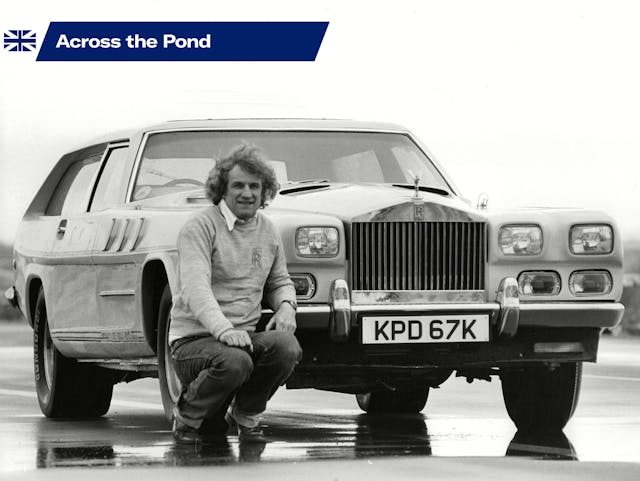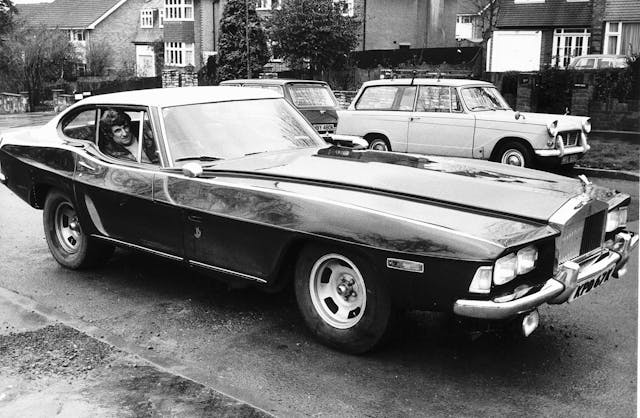The Beast: John Dodd and the 27-liter hot rod that irked Rolls-Royce

The story of “The Beast” gives credence to Mark Twain’s claim that “truth is stranger than fiction.” Somebody needs to get Ron Howard on the horn, because the director behind films like Frost/Nixon, Rush and Thirteen Lives could do a fine job of bringing this quintessentially British tale of high hopes, a high “Roller” and the High Court to the big screen. You couldn’t make it up.
John Dodd, the man most associated with one of the craziest cars of the 1970s, died early last month at the age of 90. A short statement written by his daughter on the car’s Facebook page said: “To followers on here who have not heard the news, my father John Dodd, creator of ‘The Beast’ passed away last week. He will be sorely missed but has left us with many moments and his legend will live on.”
Live on it will. Not everything that has been written about The Beast is true. Some half-truths are presented as facts. Performance figures are accompanied by words like “claimed” and “approximately.” Fifty years of myths, buts and maybes thus curdled into a plot worthy of a docufilm.
The story starts, not with Dodd nor in the 1970s, but with Paul Jameson in 1966. Jameson, described by Richard Heseltine in his book, Excess All Areas, as “an inveterate specials builder” was building his first car. Many people might start small; dip their toe in the water before cannonballing in at the deep end. Not Jameson. He wanted to create something with a 27-liter Rolls-Royce Meteor engine. Yep, 27 liters..
The Meteor was a non-supercharged version of the Merlin V-12 fitted to the Spitfire, Lancaster, and Hurricane planes, although the engine fitted to the original car had a less illustrious past, serving in a Centurion tank. Jameson paid £20 (£300 or $360 in today’s money) for the engine with blocked bores and a cracked cylinder head.
In its original form, the car—retrospectively known as the Jameson Mk1—featured a frame made of box-section girders, Jaguar Mark 10 rear suspension and a front-end comprising Wolseley 6/99 parts. According to Motor, which praised Jameson’s workmanship, the body-less car emerged with a “55/45 weight ratio and excellent handling.”
At this stage, the car was just a rolling chassis, with Jameson struggling to find a suitable clutch and gearbox. He was testing the car at Biggin Hill when he encountered Dodd, an automatic transmission specialist and serial Rolls-Royce owner based in Surrey. It was a meeting of minds, with Dodd labelling Jameson “one of the best engineers alive in Great Britain.”

Dodd supplied a gearbox with modifications, but was surprised to receive a phone call from Jameson asking if he’d be interested in buying the rolling chassis. It was delivered the same day, with Dodd turning to Fibre Glass Repairs (now FGR Motorsports) for help with the body. Predictably, for a company which specialized in dragsters, The Beast looked outlandish.
In his book, Richard Heseltine describes it as “a bodyshell akin to a steroidal Ford Capri,” while in a feature written in 2014, Octane labelled it “a grossly distended take on a Mk1 Capri.” One thing’s for sure, it was not the car that Rolls-Royce had always promised itself.
Other parts included a windscreen from a Jensen FF, rear glass from a Reliant Scimitar and seats from a Lotus Elan +2, along with a cut-down grille and Spirit of Ecstasy mascot from a Rolls-Royce Corniche. Hey, Rolls-Royce built the Meteor engine, so why not stick its famous grille and mascot on the front?
The Beast is registered as a Rolls-Royce with a 27000-cc engine, something Dodd derived great pleasure from. “And that wasn’t me,” he said in an interview, “that’s what the LCC (London County Council) decided.” Brilliant.

Rolls-Royce wasn’t amused. Speaking to Nationwide’s Christopher Rainbow in February 1974, Dodd said: “They’re not making any comments at the moment,” but things would change in 1981. More on that in a moment, because in 1975, the original car was damaged by a fire on the way back from a car show in Sweden.
Fortunately for Dodd—although not for Rolls-Royce and its lawyers—the insurance company paid £17,000 (the equivalent of £121,000) for the car and a further £1500 to remove it from Sweden. This was in addition to the £2000 BP paid to put its logo on the car. The chassis survived the fire and returned to Fibre Glass Repairs for a new body.
Incidentally, Fibre Glass Repairs was run by Bob Phelps, who along with his son Roy, owned and built Santa Pod Raceway. Dodds was always quick to credit the Phelps for their input. In an interview with Octane, he said: “Roy Phelps and his father, the late, great engineer Bob, designed and built both cars from scratch. After the fire they told me to put it back on four wheels again.”
Despite the drag strip connections, The Beast was never designed for the quarter-mile. “It was always a road car,” he told Octane.
The car emerged from FGR with a new shooting brake-style body, complete with four rear lights from a Mk1.5 Capri, Austin Westminster front suspension and steering, Jaguar XJ12 independent rear suspension with stronger driveshafts, stiffer springs, and a pair of dampers at each corner, Jaguar vented discs on the front and a GM Turbo 400 three-speed automatic transmission. Another Rolls-Royce Meteor engine was sourced from Jameson, which on this occasion had seen service in a Boulton Paul Balliol trainer aircraft.
Declining the opportunity to keep Rolls-Royce and its lawyers happy—and going against Phelps’ wishes—Dodd insisted on a R-R grille, this time from a Silver Shadow.
Nearly a decade after it made its debut at the Custom Car Show at Crystal Palace, Dodd’s creation rose like a phoenix from the flames, fueling the interest in the car and stoking the fire smoldering at Rolls-Royce. Its celebrity status extended beyond the custom car and street machine circuits.
In the May 1981 issue of Street Machine, Mike Collins wondered what made The Beast such a magnet of attention. “I’m not sure what it is exactly about the Beast which turns the media on, they’ve been offered far more powerful and exotic traffic toys and ignored them; perhaps it’s the fact that the estimated seven hundred horsepower is developed at a mind-boggling twenty-five-hundred rpm.
“On the other hand, it could be that they like Dodd’s finger up at the Establishment in the form of the Rolls grille and lady backed up with a bigger engine than most anything on the road. Itself backed by a character who fully understands what he wants from this car and gets it as he drives round most exoticars.
“It’s not so much the power which turns ordinary folks on, but more than likely the fact that the Beast features the world’s most prestigious radiator shell and mascot in front of its custom-built body, draped around a totally outrageous power plant, which is taxed and tested for street use.”
Dodd loved taunting Rolls-Royce and would often call the company pretending to be a speculative customer interested in buying a car he had just seen whizz past him on a European road. This led to the myth about a baron with a Porsche phoning Rolls-Royce after The Beast had overtaken him while driving flat-out on a German autobahn. It wasn’t a baron, it was Dodd.
Perhaps unsurprisingly, Rolls-Royce issued a High Court writ, accusing Dodd of trademark infringement. The case generated a lot of media coverage, with Dodd attending the hearing in his big, beige and bonkers car. In this Classic Driver story from 2016, Dodd says: “I drove it to the hearing every day and parked right outside the court. The Rolls-Royce representatives parked opposite in a Silver Spirit with the number plate ‘RR 1’—funnily enough, they got towed away and I didn’t.
“On the final morning of the trial, my lawyer sacked himself saying I was ridiculing the highest court in the land. His last piece of advice was not to take the car that day, otherwise it’d be confiscated and I’d never get it back.
“They said I was behaving like a maverick. Perhaps 1000 horsepower was a bit excessive, I thought, so I called a friend who had some stables in Hyde Park for a favour. Me, my wife and my children took a horse each, and clip-clopped to the doors of the Courts of Justice—that caused a bigger sensation than the car had!”
The judge ruled for Rolls-Royce’s and Dodd was fined £5000 and ordered to pay the same in costs for ignoring it two days later at a car show in Southend. Dodd lost an appeal and was sentenced to six months in prison for refusing to pay. With a warrant issued for his arrest, Dodd fled to the “Costa del Crime” to escape extradition, with the car arriving soon after, before it lost its Rolls-Royce signature pieces.
From Malaga, Dodd ran a successful automatic transmission repair business, with the locals treated to the sight and sound of The Beast, still wearing its original KPD 67K number plates. “Dad loves getting visitors to see the car!” is just one of the responses posted by his daughter Suzanne when Facebook visitors asked to see The Beast. There’s a sense that John Dodd was justifiably proud of the car and its backstory.
Unlike many entertainers from the 1970s, the celebrity status of Dodd and his magnificent non-flying machine has remained intact. Featured by some of the biggest motoring mags—check out Ollie Marriage’s 2008 road test—the car even returned to its spiritual home of Santa Pod. In 2018, Custom Car reported on a “sedate 15.23 at 91mph and 2mpg.”
Why did he do it? In the Nationwide interview, he said: “The truth is, I wanted something different. The idea was to have a car that could beat anything on earth [and] at the same time run on the cheapest [two-star] petrol you could buy.” Not wanting foreign supercars to hog the limelight, he continued: “Cruise at 200mph and beat anything else. Make it all British.”
Could it do 200 mph? The Guinness Book of Records listed it as the most powerful road car in the world, saying “it exceeded 200mph (321.8km/h) on many occasions on Continental roads.” The Daily Express claimed the car could hit 260 mph, a figure you suspect that Dodd was only too happy to endorse. In 1973, the RAC timed the car at 183 mph. Still want that F40, F1, or Veyron, etc?
Whether it’s 180 mph, 200 mph or 26 0mph, or 600 bhp, 800 bhp or 1000 bhp, The Beast is 27 liters of flamboyant, anti-establishment excess. On an episode of Top Gear, in which Steve Berry is somehow louder than the engine, Dodd said the 19-foot-long and two-ton car would consume eight pints of fuel a minute, delivering just 2 mpg. The small numbers of The Beast are just as outrageous as the big ones.
There are other stories, like the time Dodd allegedly outran a police helicopter on a drive from Ayr to Carlisle. A police Range Rover failed to stop him, with Dodd escaping prosecution because the traffic cop couldn’t identify the driver. A screenwriter would never be short of inspiration when telling the story of Dodd and his car.
With the passing of John Dodd, the motoring world has lost an eccentric and driven individual who cared deeply about the car he co-created. Thanks to The Beast, his legend will indeed live on. Ron Howard, it’s over to you …
***
Check out the Hagerty Media homepage so you don’t miss a single story, or better yet, bookmark it.


The world needs more John Dodd’s.